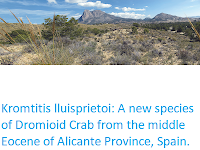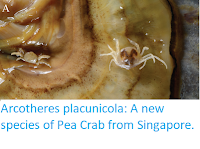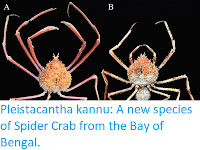Crabs are Decapod Crustaceans related to Shrimps, Crayfish and
Lobsters. Most Crabs occupy marine environments; however Freshwater and Land
Crabs are widespread in the tropics. Members of the Family Potamonautidae are found across Africa, as well as Madagascar, the Seychelles, Zanzibar, Mafia, and Pemba islands in the Indian Ocean, and Bioko, São Tomé, Príncipe, and Sherbro islands in the Atlantic. The genus Louisea is known only from Cameroon, with two described species, Louisea edeaensis from the Lake Ossa wetland complex, and Louisea balssi from Kumba and Mt. Manengouba.
In a paper published in the journal ZooKeys on 17 Ocrober 2019, Pierre Mvogo Ndongo of the Department of Management of Aquatic Ecosystems at the University of Douala at Yabassi, the Museum für Naturkunde at the Leibniz-Institut für Evolutions und Biodiversitätsforschung, and the the Department of Biology at Northern Michigan University, Thomas von Rintelen, also of the Museum für Naturkunde at the Leibniz-Institut für Evolutions und Biodiversitätsforschung, and Neil Cumberlidge, also of the Department of Biology at Northern Michigan University, describe two new species of Louisea, both from Cameroon.
The first new species is named Louisea yabassi, in reference to the Yabassi Coastal Rain Forest where it was discovered. The species is described from two specimens, an adult male 18.11 mm wide and 12.78 mm long, and a subadult male 13.82 mm wide and 10.61 mm long. Both were collected in 1909 by Fritz Wilhelm Riggenbach, and were found in the collection of the Museum für Naturkunde. Louisea yabassi has a smooth, flat and nearly oval carapace, and unequal claws, with the right being larger than the left.
The second new species is named Louisea nkongsamba, in reference to Nkongsamba, the closest town to the Nlonako Wildlife Reserve, where the species was discovered. This species is described from two adult male specimens collected by Pierre Mvogo Ndongo, the larger of these being 20 mm wide and 14.85 mm long, the smaller 18.38 mm wide and 13.32 mm wide. Louisea nkongsamba has a smooth oval carapace, a stout but different-sized claws and slender walking legs. It is dark green or brown in life.
See also...
In a paper published in the journal ZooKeys on 17 Ocrober 2019, Pierre Mvogo Ndongo of the Department of Management of Aquatic Ecosystems at the University of Douala at Yabassi, the Museum für Naturkunde at the Leibniz-Institut für Evolutions und Biodiversitätsforschung, and the the Department of Biology at Northern Michigan University, Thomas von Rintelen, also of the Museum für Naturkunde at the Leibniz-Institut für Evolutions und Biodiversitätsforschung, and Neil Cumberlidge, also of the Department of Biology at Northern Michigan University, describe two new species of Louisea, both from Cameroon.
The first new species is named Louisea yabassi, in reference to the Yabassi Coastal Rain Forest where it was discovered. The species is described from two specimens, an adult male 18.11 mm wide and 12.78 mm long, and a subadult male 13.82 mm wide and 10.61 mm long. Both were collected in 1909 by Fritz Wilhelm Riggenbach, and were found in the collection of the Museum für Naturkunde. Louisea yabassi has a smooth, flat and nearly oval carapace, and unequal claws, with the right being larger than the left.
Largest adult male of Louisea yabassi. from Yabassi (missing left p2–p5, and right cheliped and p2, p3). Scale bar is 8.42 mm. Mvogo Ndongo et al. (2019).
The second new species is named Louisea nkongsamba, in reference to Nkongsamba, the closest town to the Nlonako Wildlife Reserve, where the species was discovered. This species is described from two adult male specimens collected by Pierre Mvogo Ndongo, the larger of these being 20 mm wide and 14.85 mm long, the smaller 18.38 mm wide and 13.32 mm wide. Louisea nkongsamba has a smooth oval carapace, a stout but different-sized claws and slender walking legs. It is dark green or brown in life.
Second largest adult male of Louisea nkongsamba from Mt. Nlonako. Scale bar is 11.63 mm. Mvogo Ndongo et al. (2019).
See also...
Follow Sciency Thoughts on
Facebook.








